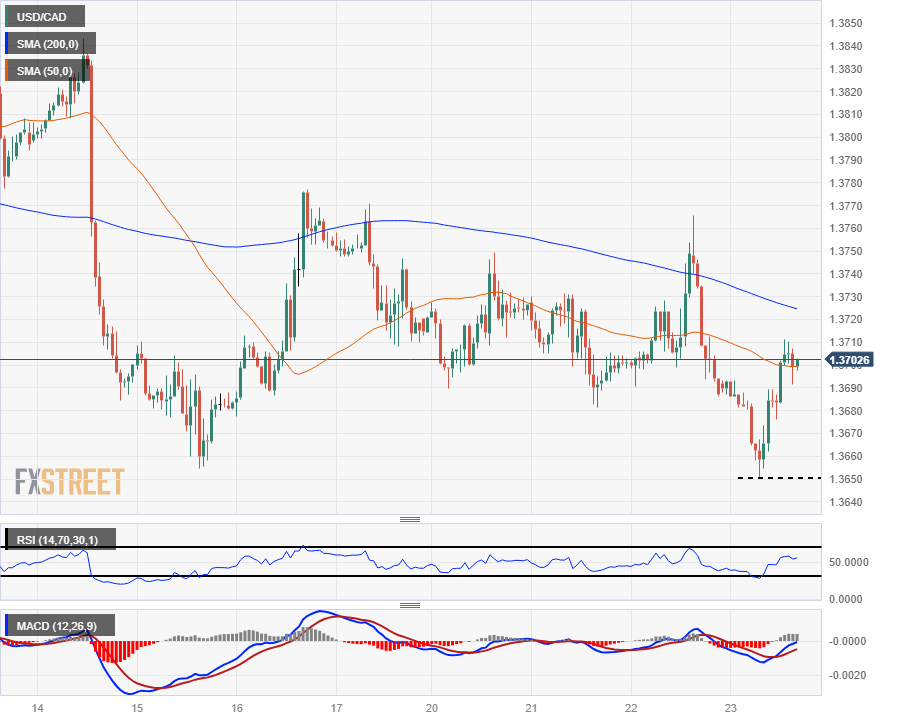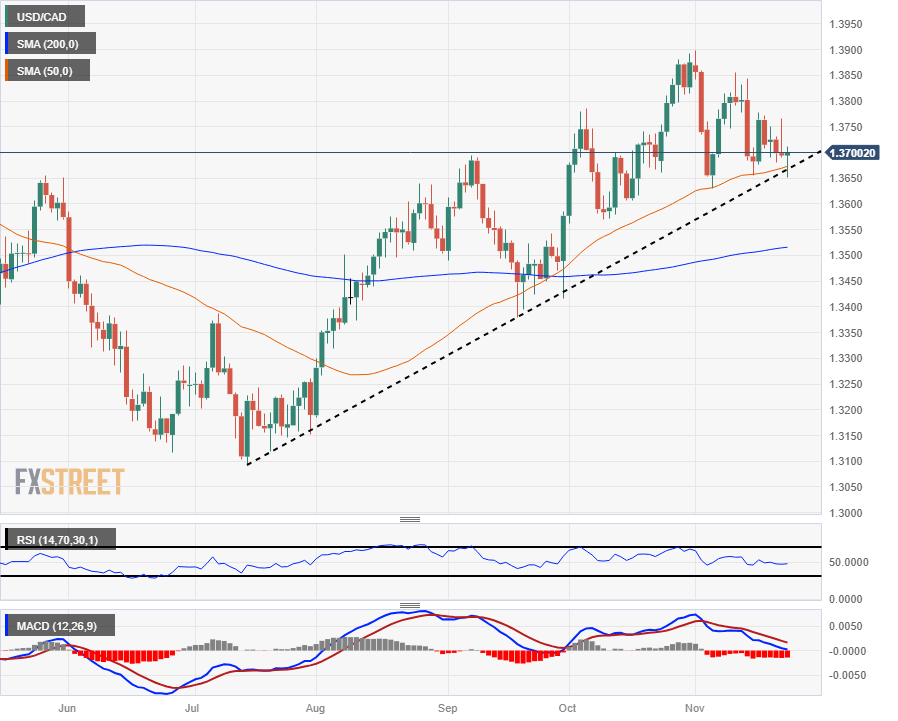- Phân tích
- Tin tức và các công cụ
- Tin tức thị trường
- Canadian Dollar treading water in US holiday markets
Canadian Dollar treading water in US holiday markets
- The Canadian Dollar is catching a breather as the Loonie market goes flat.
- Friday’s Canada Retail Sales to be overshadowed by US PMIs.
- Thursday set to be a quiet session with the US out for Thanksgiving.
The Canadian Dollar (CAD) is holding steady on Thursday, with the USD/CAD trading closely with the day’s opening bids. Friday will see US equity markets return to the fold for a reduced trading day before shutting down again for the weekend.
Friday will also see the latest round of Retail Sales from Canada, but the release is likely to be overshadowed by the US Purchasing Managers’ Index (PMI) release.
Daily Digest Market Movers: Canadian Dollar sees little movement, constrained by slightly softer Crude Oil
- The CAD is grinding into the middle as US holiday trading volumes deflate market momentum.
- The Loonie initially kicked higher on the day but quickly fell back to Thursday’s opening bids.
- Crude Oil is seeing some downside play, limiting CAD support.
- In a speech on Wednesday, Bank of Canada (BoC) Governor Tiff Macklem highlighted that BoC policymakers “might” have done enough to tame inflation, balance economy.
- Friday’s CAD Retail Sales to have limited impact as traders focus on US PMIs.
- Median market forecasts are expecting flat results or slight declines in both data sets.
- CAD Retail Sales in September expected to print 0.0%, previous -0.1%.
- Retail Sales Excluding Vehicles is expected to reveal a -0.2% decline in consumption spending.
- US November PMIs are forecast to decline in both the Services and Manufacturing components.
- Services are forecast to tick lower from 50.6 to 50.4, while Manufacturing is expected to fall into contractionary territory at 49.8 versus October’s 50.0.
Canadian Dollar price this week
The table below shows the percentage change of Canadian Dollar (CAD) against listed major currencies this week. Canadian Dollar was the strongest against the US Dollar.
| USD | EUR | GBP | CAD | AUD | JPY | NZD | CHF | |
| USD | 0.00% | -0.65% | -0.17% | -0.76% | -0.25% | -0.86% | -0.28% | |
| EUR | 0.00% | -0.67% | -0.17% | -0.76% | -0.25% | -0.86% | -0.26% | |
| GBP | 0.65% | 0.66% | 0.51% | -0.09% | 0.42% | -0.19% | 0.38% | |
| CAD | 0.17% | 0.17% | -0.49% | -0.57% | -0.07% | -0.69% | -0.10% | |
| AUD | 0.74% | 0.75% | 0.10% | 0.58% | 0.51% | -0.10% | 0.49% | |
| JPY | 0.24% | 0.24% | -0.66% | 0.07% | -0.52% | -0.62% | -0.04% | |
| NZD | 0.87% | 0.86% | 0.21% | 0.69% | 0.10% | 0.61% | 0.58% | |
| CHF | 0.28% | 0.28% | -0.37% | 0.11% | -0.47% | 0.03% | -0.58% |
The heat map shows percentage changes of major currencies against each other. The base currency is picked from the left column, while the quote currency is picked from the top row. For example, if you pick the Euro from the left column and move along the horizontal line to the Japanese Yen, the percentage change displayed in the box will represent EUR (base)/JPY (quote).
Technical Analysis: Canadian Dollar gets hung out to dry in holiday trading, USD/CAD goes flat near 1.3700
The Canadian Dollar (CAD) is losing all momentum on Thursday, trading closely with the day’s opening bids of 1.3700 against the US Dollar (USD). The USD/CAD briefly fell into a new low for the week as the Loonie found some bidding (or the Greenback just lost some steam), but a slight softening in Crude Oil bids is pulling the CAD back into the day’s starting gate.
The USD/CAD briefly dipped into 1.3650 before getting pushed back into near-term median bids at the 50-hour Simple Moving Average (SMA). Intraday action continues to see constraint from the 200-hour SMA declining into 1.3720.
On the daily candlesticks, Thursday’s bounce back into 1.3700 makes more sense following a rebound from the 50-day SMA, and technicals are lining up for a slow grind with technical support from the 50 and 200-day SMAs at 1.3670 and 1.3512, respectively.
Technical indicators are leaning into the midrange as momentum leaks out of the USD/CAD chart in the medium term. The Relative Strength Index (RSI) is drifting around the 50.0 middle level, while the Moving Average Convergence Divergence (MACD) has multiple levels of moving averages constraining it into the zero threshold, indicating an overall lack of strength in either direction.
USD/CAD Hourly Chart
 USD/CAD Daily Chart
USD/CAD Daily Chart

Canadian Dollar FAQs
What key factors drive the Canadian Dollar?
The key factors driving the Canadian Dollar (CAD) are the level of interest rates set by the Bank of Canada (BoC), the price of Oil, Canada’s largest export, the health of its economy, inflation and the Trade Balance, which is the difference between the value of Canada’s exports versus its imports. Other factors include market sentiment – whether investors are taking on more risky assets (risk-on) or seeking safe-havens (risk-off) – with risk-on being CAD-positive. As its largest trading partner, the health of the US economy is also a key factor influencing the Canadian Dollar.
How do the decisions of the Bank of Canada impact the Canadian Dollar?
The Bank of Canada (BoC) has a significant influence on the Canadian Dollar by setting the level of interest rates that banks can lend to one another. This influences the level of interest rates for everyone. The main goal of the BoC is to maintain inflation at 1-3% by adjusting interest rates up or down. Relatively higher interest rates tend to be positive for the CAD. The Bank of Canada can also use quantitative easing and tightening to influence credit conditions, with the former CAD-negative and the latter CAD-positive.
How does the price of Oil impact the Canadian Dollar?
The price of Oil is a key factor impacting the value of the Canadian Dollar. Petroleum is Canada’s biggest export, so Oil price tends to have an immediate impact on the CAD value. Generally, if Oil price rises CAD also goes up, as aggregate demand for the currency increases. The opposite is the case if the price of Oil falls. Higher Oil prices also tend to result in a greater likelihood of a positive Trade Balance, which is also supportive of the CAD.
How does inflation data impact the value of the Canadian Dollar?
While inflation had always traditionally been thought of as a negative factor for a currency since it lowers the value of money, the opposite has actually been the case in modern times with the relaxation of cross-border capital controls. Higher inflation tends to lead central banks to put up interest rates which attracts more capital inflows from global investors seeking a lucrative place to keep their money. This increases demand for the local currency, which in Canada’s case is the Canadian Dollar.
How does economic data influence the value of the Canadian Dollar?
Macroeconomic data releases gauge the health of the economy and can have an impact on the Canadian Dollar. Indicators such as GDP, Manufacturing and Services PMIs, employment, and consumer sentiment surveys can all influence the direction of the CAD. A strong economy is good for the Canadian Dollar. Not only does it attract more foreign investment but it may encourage the Bank of Canada to put up interest rates, leading to a stronger currency. If economic data is weak, however, the CAD is likely to fall.
© 2000-2024. Bản quyền Teletrade.
Trang web này được quản lý bởi Teletrade D.J. LLC 2351 LLC 2022 (Euro House, Richmond Hill Road, Kingstown, VC0100, St. Vincent and the Grenadines).
Thông tin trên trang web không phải là cơ sở để đưa ra quyết định đầu tư và chỉ được cung cấp cho mục đích làm quen.
Giao dịch trên thị trường tài chính (đặc biệt là giao dịch sử dụng các công cụ biên) mở ra những cơ hội lớn và tạo điều kiện cho các nhà đầu tư sẵn sàng mạo hiểm để thu lợi nhuận, tuy nhiên nó mang trong mình nguy cơ rủi ro khá cao. Chính vì vậy trước khi tiến hành giao dịch cần phải xem xét mọi mặt vấn đề chấp nhận tiến hành giao dịch cụ thể xét theo quan điểm của nguồn lực tài chính sẵn có và mức độ am hiểu thị trường tài chính.
Sử dụng thông tin: sử dụng toàn bộ hay riêng biệt các dữ liệu trên trang web của công ty TeleTrade như một nguồn cung cấp thông tin nhất định. Việc sử dụng tư liệu từ trang web cần kèm theo liên kết đến trang teletrade.vn. Việc tự động thu thập số liệu cũng như thông tin từ trang web TeleTrade đều không được phép.
Xin vui lòng liên hệ với pr@teletrade.global nếu có câu hỏi.















